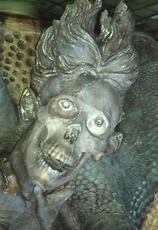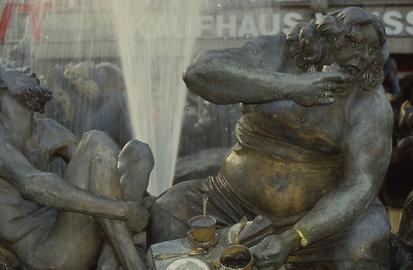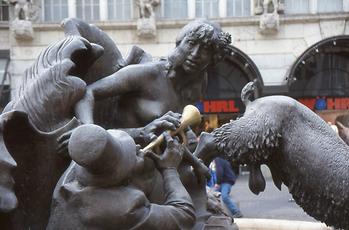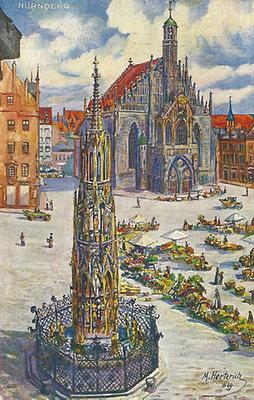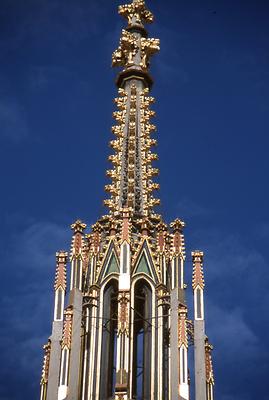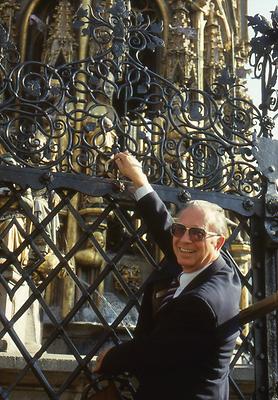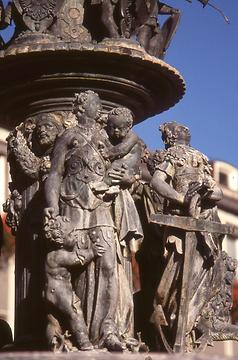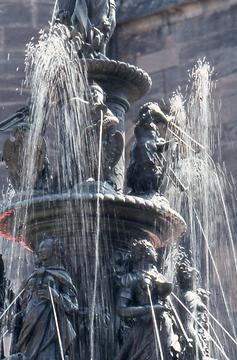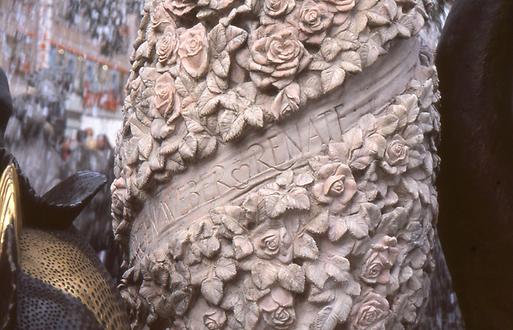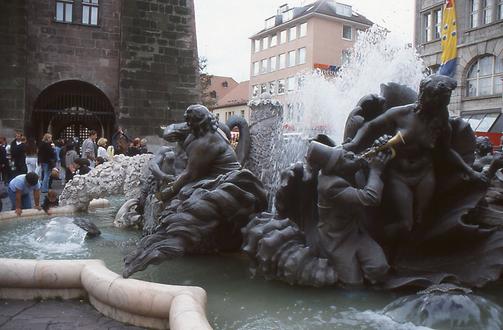Nuremberg, city of fountains#
Three of the most beautiful fountains of Gothic Renaissance and present times in words and images #
The photos were taken in the years 1983 and 2011, and are part of the archive “Pictureflood Jontes”
The geological structure of the imperial city of Nuremberg makes sure that not only the small river, the Pegnitz, flows through the city area. The huge sandstone rock, bearing the Imperial Castle, has a stratification which contains four groundwater horizons. It was enough in the past to supply the whole city with healthy and pure water. Already in the Middle Ages, a kind of aquaduct which came from far away had been built to supply the public hospital with water. The aquaduct brought additional water for this urban social institution.
Based on these resources, the city had numerous drawing wells at the burgher’s houses and was able to guarantee access to water, an element essential to life, through its overflow fountains. Today, around fifty fountains are in the old part of the city within the preserved wall ring. Many are artistic masterpieces of bronze casting and stone cutting from the Gothic to post-modernism. A description of three treasures should show that Nuremberg was not only one of the richest capitals of the Roman-German Empire, but had also a cultural structure in which stars like Albrecht Dürer and Hans Sachs could rise.
Our ancestors saw it as follows:
The beautiful fountain ("Der Schöne Brunnen")#

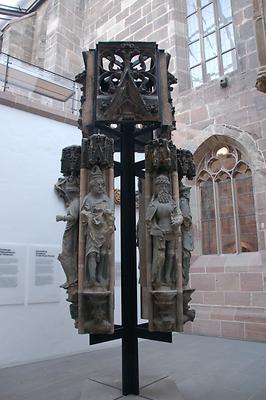
If a fountain was called "Beautiful Fountain" in the Middle Ages, it was probably the most beautiful of all. Still today, this fountain is the most beautiful one. The city has around fifty old and new decorative fountains within its historically preserved wall ring. The main market is the centre of the old town of Nuremberg and the market place for fruits, vegetables and rural products of all kinds from the beginnings to today. On its east side, the “Church of our Lady” rises as a Catholic parish church with its miraculous mechanical clock called "Männleinlaufen". The most beautiful German medieval fountain construction is situated opposite the north-western corner. The Roman-German Emperor Charles IV who had a positive attitude towards Nuremberg commissioned the fountain. It was built ten years from 1385 to 1396. Most probably it was designed and built by Beheim the Elder from the Parler School in Prague. The splendid coloured frames and gildings were created by Master Rudolf.
Today’s fountain is a faithful copy of the 19th and the early 20th century. The ravages of time left traces on the medieval sandstone fountain construction and the statues making it necessary to build a new one in long-lasting shell limestone. Some of the original statues now in a museum. The fountain survived the bomb attacks of the Second World War because it was totally enclosed by concrete.
The architectural structure of the fountain is a 20 m high tower which looks like a Gothic church tower in half-open tracery with bouquets, crabs and pinnacles.
The structure carries a treasure of 40 fully sculptural figures which follow a precise iconographic program. Water comes out of numerous grotesquely designed water outlets. Once, water could be drawn from the lower retention basin. Today, the access to the basin is closed with an artistic wrought-iron grid.
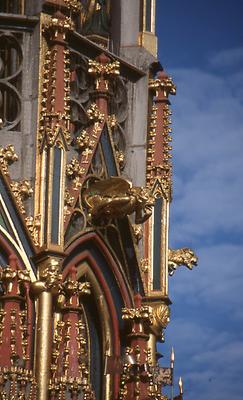










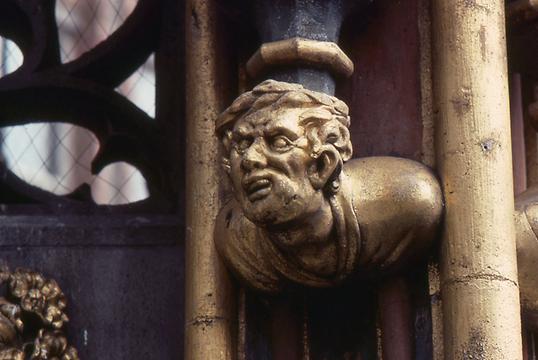
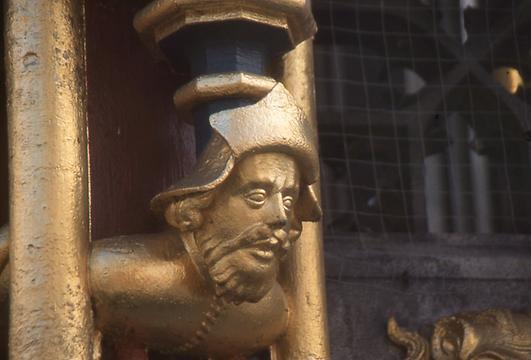
The artistic iron grid has been surrounding the fountain since 1587 was made by the master locksmith Paul Kuhn from Augsburg, at a time when the German renaissance had emancipated itself from the Italian. It consists of a detailed figural decor consisting of lovely designed mythical creatures as unicorns, nymphs, etc. The beautiful grid is closed with a lock and protects the fountain.
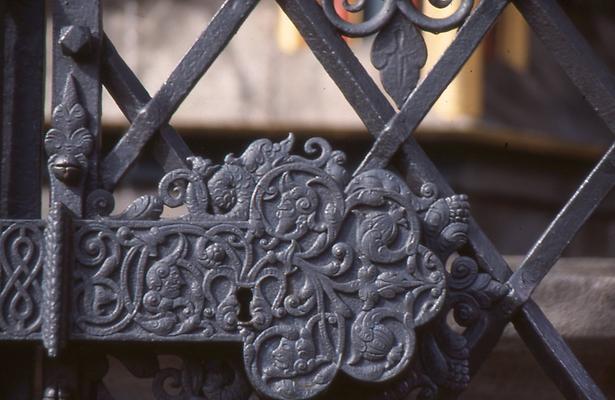


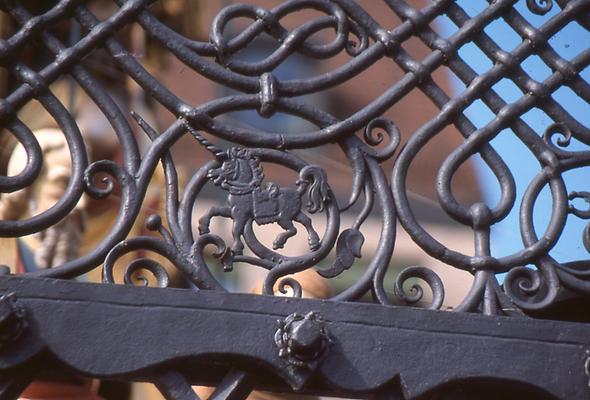

The visitor is amazed at the craftsmanship with which the seamless, flexible brass ring is inserted into the iron grid. Reportedly, anyone who manages to turn the ring upward can will have some stroke of luck the same day.
On consoles under canopies, there are 40 figures representing a well-defined group of biblical, antique and medieval secular and spiritual celebrities. On the second floor, there are the great prophets and Jewish heroes of the Old Testament. Even “pagan” rulers such as Caesar or Alexander the Great and Hector appear on the first floor. Among the Christian ones considere similarly importatn are Charles the Great, King Arthur and Godfrey of Bouillon. Even the seven electors of Roman-German Empire are not missing. On the upper edge of the basin, the four evangelists and church fathers are worshiped. The great spirits of the Greek and Roman antiquity Pythagoras, Euclid, Ptolemy, Nikomachos, Socrates and Aristotle, as well as Cicero and Donatus gather at the bottom of the basin. The spiritual openness which can be found here becomes self-evident a century later, only. The beautiful fountain is a monument of a mentally superior city looking at all possibilities.
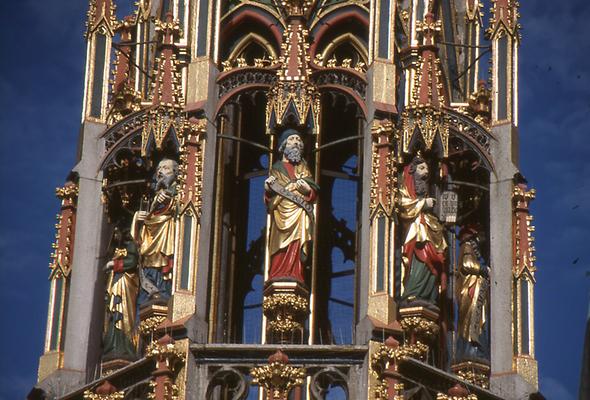

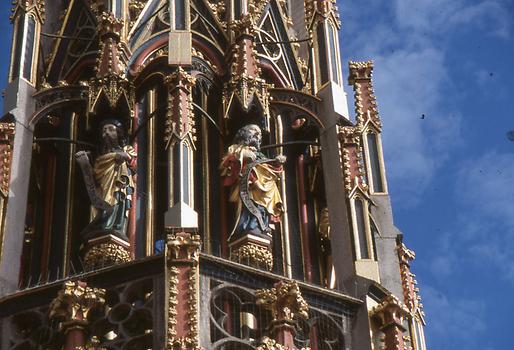
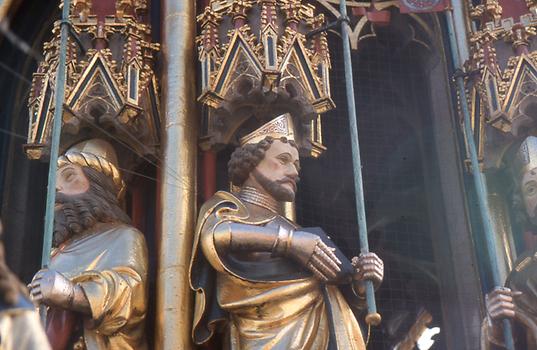
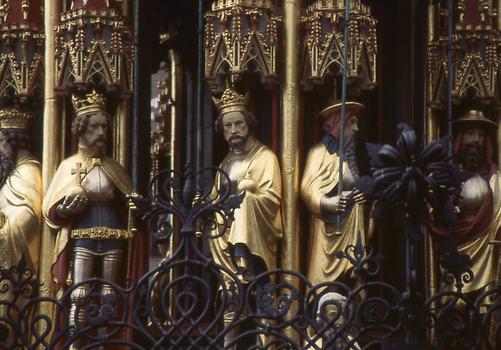



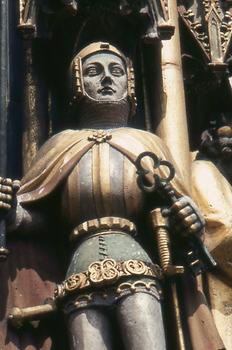

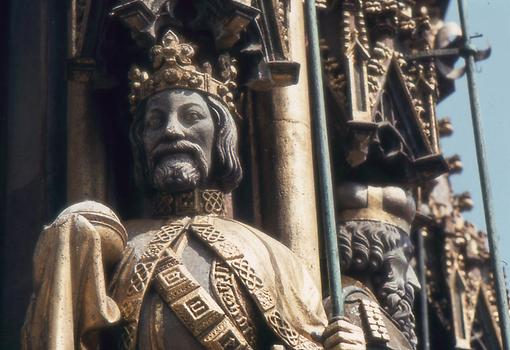

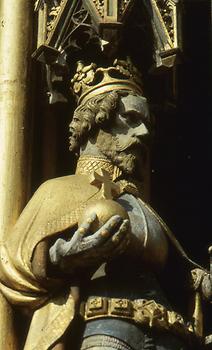

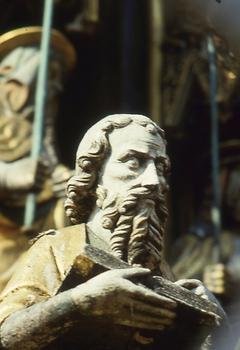

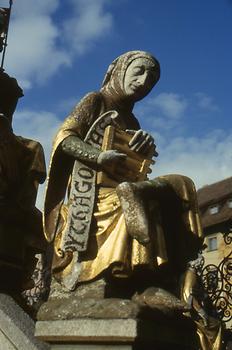

The Fountain of the Virtues#
In Christianity, seven virtues are named as ideals of character. Plato already emphasized four of them which were then named as cardinal virtues by Saint Ambrosius: Justice (Justitia), Faith (Fides), Love (Caritas), Hope (Spes). In its pictorial program, the Nuremberg Fountain of the Virtues unites the ancient pagan and Christian allegories to become a then modern whole which corresponds to the new spirituality of the Renaissance.
On an octagonal basin, there are three storeys, the upper one of which is almost the most important of all virtues. It is the righteousness with blindfolded eyes, the scale and the sword.




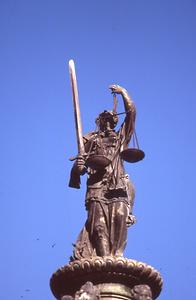
Further virtues are represented by six angels, resembling putti, and six female figures with corresponding attributes. Now and then, a stream of water flows out of all artistic bronze sculptures. Depending on the light and the time of day, the water forms a sparkling transparent curtain. When the wind turns, a water mist is cooling the visitors.
Caritas as loving mother with two children and Spes, the hope with an anchor is seen in the first image.
The splashing breasts of the female figures were by no means regarded as offensive at that time. Even the Mother of God is shown, suckling the child Jesus.
The Fountain of Virtues is situated directly at the northern-west edge of the Gothic Lorenzer parish church. Its construction took five years from 1584 to 1589. It was built by the local sculptor and brass caster Benedikt Wurzelbauer who proudly signed his masterpiece after completion.
#
Hans Sachs – Marriage Carousel as fountain of our time#
A whole series of historical fountains were commissioned by the city council of Nuremberg. It combined the idea of water supply with a municipal need for representation which continues to present time. 1987 the sculptor and iron caster Professor Jürgen Weber (1928 Münster – 2007 Ibiza) got the order to construct a fountain on the western side of the Nuremberg Ludwigplatz directly in front of the White Tower. The artist himself carved the sculptures out of Portuguese marble. The brass sculptures were cast according to his drafts in Gerlingen near Munich. The implementation of the drafts was started in 1977. The monumental work was completed in 1984 to the complete amazement of the enthusiastic audience from near and far.
However, the artist and his work were not spared from criticism. The realism of the whole and of the detail was found as “too baroque”. It was also criticised that he dared to implement pictorially a centuries-old amusing story at a time where feminist movements started to throw campaign slogans against the disdainful male world. Another stylistically parallel work of Weber, the “Fool’s ship” in the old town, was designed as a fountain. However, local bigotry knew how to prevent it. Today, the sculptural masterpiece is just a dry fountain.
However, the „Marriage Carousel “(Ehekarussell) is rich in figures and represents a chaotic crowd of bodies, mythical creatures of man and beast. Love scenes and subsequent disputes are followed by blood and thunder. This masterpiece of a fountain is presented as carousel, a merry-go-around. This is obvious from the fact that the single illustrative scenes take place on six carts that form a circle.
Above all of this, Hans Sachs “showmaker and poet” is dancing and is laughing so hard, he almost falls over. Everywhere there is water pouring from all sides into the big, beautifully fringed basin.
The sweet-bitter life of marriage ('Das bittersüß ehlich Leben)#
The 19th century saw Hans Sachs in this way. His monument of 1874 is in front of his former home and working place that was destroyed by allied bombing in 1943.
The “Marriage Carousel” orients itself on a poem which Hans Sachs wrote in 1541. In this poem he describes the contrarities in a married life. In this particular case he describes his own life and writes the poem in the I-form with a twinkle in his eye, meaning that it is a droll story. The name of the poem is
The bittersweet married life (Das bittersüß ehlich Leben)#
(No translation provided. All married women and men will have experienced ups an downs in their marriage as described, in the poem the ups are dominating)Gott sei gelobet und geehrt,/
der mir ein frumb Weib hat beschert,
Mit der ich zwei und zweinzig Jahr
Gehaust hab, Gott gab länger gar.
Wiewohl sich in mein ehling Leben
Hat Süß und Saures oft begeben,
Gar wohl gemischt von Freud und Leid,
Erst auf, dann ab, ohn Unterscheid.
Sie hat mir nit stets kochet Feigen,
Will schwankweis dir ein Teil anzeigen.
Sie ist ein Himmel meiner Seel,
Sie ist auch oft mein Pein und Hell,
Sie ist mein Engel auserkoren,
Ist oft mein Fegeteufel woren,
Sie ist mein Wünschelrut und Segen,
Ist oft mein Schauer und Platzregen,
Sie ist mein Mai und Rosenhag,
Ist oft mein Blitz und Donnerschlag,
Mein Frau ist oft mein Schimpf und Scherz,
Ist oft mein Jammer, Angst und Schmerz,
Sie ist mein Wunn und Augenweid,
Ist oft mein Traurn und Herzeleid,
Sie ist mein Freiheit und mein Wahl,
Ist oft mein Gfengnis und Notstall,
Sie ist mein Hoffnung und mein Trost,
Ist oft mein Zweifel, Hitz und Frost,
Mein Frau ist meine Zier und Lust,
Ist oft mein Graun und Suppenwust,
Ist oft mein königlicher Sal,
Ist oft mein Krankheit und Spital,
Mein Frau, die hilft mir treulich nähren,
Thut mir auch oft das Mein verzehren,
Mein Frau, das ist mein Schild und Schutz,
Ist oft mein Frevel, Poch und Trutz,
Sie ist mein Fried und Einigkeit
Und oft mein täglich Hebenstreit,
Sie ist mein Fürsprech und Erlediger,
Ist oft mein Ankläger und Prediger,
Mein Frau ist mein getreuer Freund,
Oft worden auch mein größter Feind,
Mein Frau oft mietsam ist und gütig,
Sie ist auch zornig oft und wütig,
Sie ist mein Tugend und mein Laster,
Sie ist mein Wund und auch mein Pflaster,
Sie ist mein Herzens Aufenthalt,
Und machet mich doch grau und alt.
The group with the peaceful lovers does not exclude the possibility of some troubles that will follow.
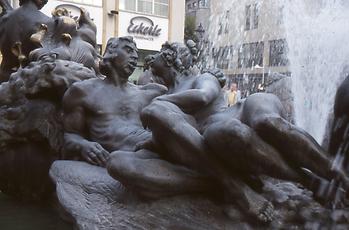


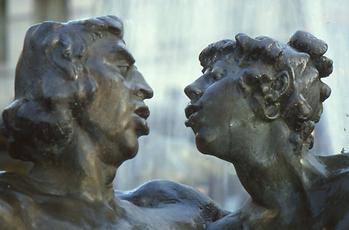
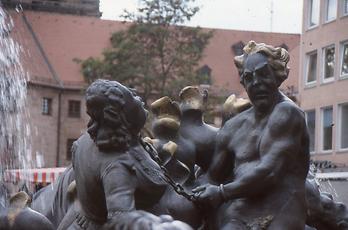
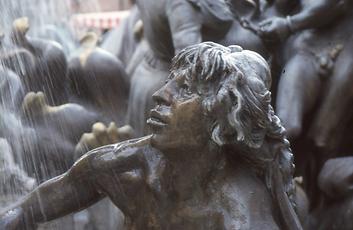



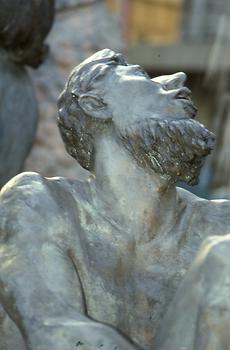
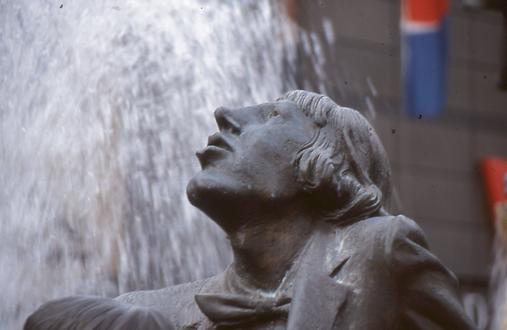

The rose garden which only a few people will reach in real life is shown in fine decor.





